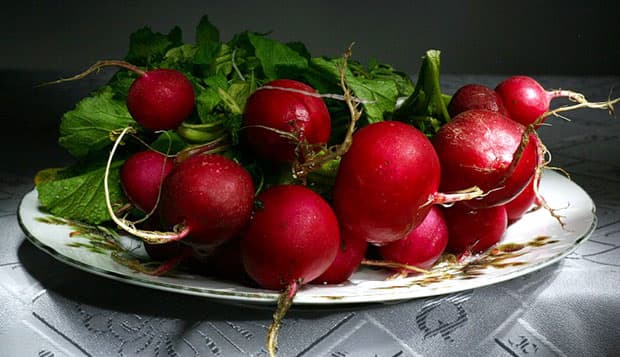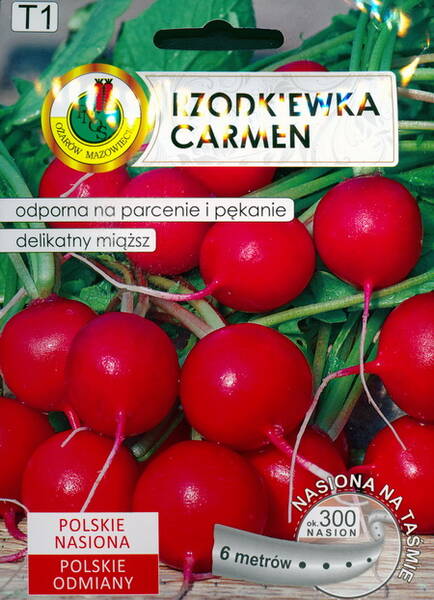Early ripening variety: from germination to ripening 20-22 days.
Root crops of red color, round, weighing 10-15 g, but can reach a weight of up to 60 g (with late harvest), juicy, with a slight "speck".
The pulp is dull white with a pink tint, juicy, tasty.
The variety is resistant to cracking and bitterness.
Grade yield: 1.5-1.9 kg / m2.
Distinctive qualities of the variety: resistance to flowering, low level of stemming, suitability of root crops for late harvesting, excellent transportability.
This variety is perfectly stored, while maintaining its presentation.

Eng.: Radish. Suom.: Retiisi. Sven.: Rädisa. Bot.: Raphanus sativus L. var. sativus.
* RADISH IN THE SPRING GREENHOUSE.
But if the radish has been known to people since ancient times, then the radish has been cultivated in Europe only since the 16th century.
It is the first root vegetable to appear on our table in early spring during a period of vitamin deficiency and is the basis of most spring salads. Moreover, during the season, you can easily collect three harvests of radish.
For an early vegetable, radish contains quite a lot of vitamin C - up to 30 mg%, and in an easily accessible form.
(Radish tops also contain a lot of vitamin C, but for some reason gardeners do not remember this).
Radish is rich in essential oils that have a positive effect on all digestion processes, suppressing various harmful microorganisms. Radish juice is very rich in potassium salts, which is very useful in the treatment of kidney and cardiovascular diseases.
Radish can also be used as an anti-inflammatory agent when other options are not available. So, for colds, radish juice mixed with onion juice and pepper is useful.
A mixture of radish juice with carrot juice restores the tone of the mucous membrane in the body.
There are known European and Asian subgroups of radish varieties. Varieties of European origin are very early ripening, but they are poorly stored and relatively small (only these varieties should be grown in spring greenhouses).
Radish is quite cold-resistant. Its seeds begin to germinate at a temperature of + 3 + 4 ° С, the seedlings tolerate frosts down to minus -2-3 ° С. However, long-term exposure to low temperatures slows down development and can cause plant shoots. Therefore, very early sowing is desirable in greenhouses with additional plant cover with foil.
In the greenhouse, before the emergence of seedlings, it is necessary to maintain the temperature at + 16 + 18 degrees. When seedlings appear, so that the plants do not stretch, the temperature must be lowered to + 10 ° C and maintained until the first true leaf appears. Then the temperature must be raised to + 15 + 18 ° C.
Radishes are picky about good lighting. With dense planting, the plants will shade each other, quickly "shoot" and will not give a crop. But good roots can be obtained only with a short daylight hours (no more than 10-11 hours), otherwise the plants will form flowering stems.
That is why experienced gardeners strive to sow radishes as early as possible in the spring. For the same reason, from the second half of May to the end of July, when daylight hours reach a maximum, most varieties of radish fail. And in order to avoid this, at the height of summer, the garden beds with radishes should be covered with a black film from 8 am to 6 pm.
Radish is also picky about soil moisture (within 60-70%). With its lack and high air temperature, the roots become coarse and flabby. To prevent this from happening, it is necessary to mulch the soil around the plants with peat. And excess water in the soil can lead to stunted growth, yellowing of leaves and insufficient color of the fruit.
Radish is picky about soil fertility and the presence of nutrients in it in an easily digestible form. Clay soils are unsuitable for growing it, but it is not picky about the acidity of the soil. It grows well on soils from neutral to acidic, therefore liming of the soil is carried out only on very acidic soils.















